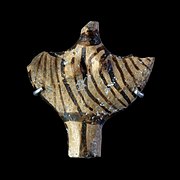Tau-, Psi- and phi- type Greek terracotta figurines date back to 1450–1100 BC in Mycenaean Greece. They were typically small (about 10cm high), made of terracotta, and were found in tombs, shrines and settlement areas. They are classified by their shape and a resemblance to the Greek letters of tau (τ), psi (ψ) and phi (Φ), according to a typological system created by Arne Furumark in 1941.[1]

Their function/purpose is unknown, although it has been suggested that their purpose changed with the context in which they were found. Possible uses were children's toys,[2] votive figurines or grave offerings.
Some figurines appear to wear flattened headdresses, which suggests they may be goddesses.[3] However, it is difficult to distinguish between goddesses and worshippers. It is likely that they were made by the same craftsmen who made Mycenaean vases, as the decoration techniques are similar.[3]
Examples of such figurines are held by the Goulandris Museum of Cycladic Art (Athens),[4] the British Museum (London),[5] and the Metropolitan Museum of Art (New York) among other places.[6]
-
Psi-shaped figurine on display at the Musée d'Art et d'Histoire de Genève
-
Phi-type and Psi-type Mycenaean female figurines; Museum of Cycladic Art, Athens. 14th–12th century BC
-
Mycenaean figurines, "Bird goddesses", 14th–13th century BC
-
Example of a Psi-shaped figurine of a woman. Mycenaean import found in Ugarit by Claude F. A. Schaeffer and Georges Chenet.
See also
editReferences
edit- ^ French, Elizabeth (1971). "The Development of Mycenaean Terracotta Figurines". The Annual of the British School at Athens. 66: 101–187. doi:10.1017/S0068245400019146. JSTOR 30103231. S2CID 194064357.
- ^ Olsen, Barbara A (February 1998). "Women, Children and the Family in the Late Aegean Bronze Age: Differences in Minoan and Mycenaean Constructions of Gender". World Archaeology. 29 (3): 380–392. doi:10.1080/00438243.1998.9980386. JSTOR 125037.
- ^ a b British Museum. "Three terracotta figurines". Retrieved 17 July 2012.
- ^ "Female figurine (Psi type) | Museum of Cycladic Art". cycladic.gr. Retrieved 22 December 2018.
- ^ "figure". British Museum. Retrieved 22 December 2018.
- ^ "3 Terracotta female figures". www.metmuseum.org. Retrieved 22 December 2018.



